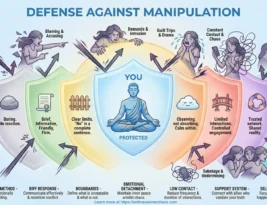Learn how to identify narcissistic traits in your brother with this step-by-step quiz. Protect your emotional well-being today. …
Blog Posts
Identify narcissistic eyes with 7 key signs, including intense stares, emotional voids, and manipulative gaze patterns. Learn how these traits reveal behavior. …
Understand covert narcissist post-breakup behaviors like silent treatment, smear campaigns, and hoovering. Learn why they act this way and how to protect yourself. …
Unmask female narcissists over 50 with these essential recognition strategies. Aging narcissists use distinctive manipulation tactics—learn to protect your boundaries today. …
Discover 7 facial tells that expose narcissists—contempt smirks, predatory stares, and micro-expressions revealing hidden arrogance. …
Understand high-functioning narcissists, their traits, and behaviors. Learn how to identify them and protect your emotional well-being in relationships and work. …
Understand the traits of a neglectful narcissist, their impact on relationships, and how to set boundaries. …
Do Narcissists’ Black Eyes Reveal a Disturbing Secret? …
The Science Behind Crafting the Perfect Yellow Rock Reply (It's Easier Than You Think!) …
Identifying Subtle Manipulations and Impact of Covert Narcissistic Sister on Family Dynamics …
9 Things Narcissists Do When They Lose Control Over You: Recognize manipulative tactics like gaslighting, rage, and silent treatment to protect yourself. …
Spot the signs you are working with a narcissist—credit stealing, lack of empathy, and manipulation. Learn how to protect yourself and your team. …
Key narcissistic terms explained to help you spot manipulation, set boundaries, and break free from psychological dominance in toxic relationships. …
FInd how to deal with a covert narcissistic sister. Set boundaries, protect your mental health and find practical steps to handle manipulation and family stress. …
Sons of narcissistic fathers often face low self-esteem, anxiety, and trust issues that impact their relationships and sense of self into adulthood. …
Wondering if you're narcissistic or a victim? Learn key signs, self-check tips, and how to recognize mixed patterns in your relationships. …













